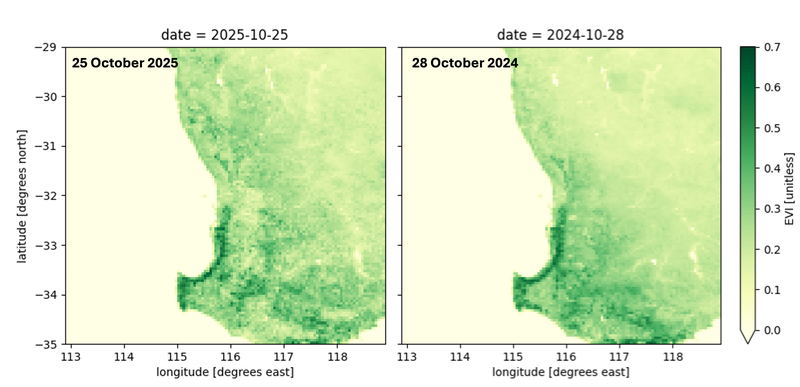Seasonal Outlook for the 2025 Perth grass pollen season
Oct. 27, 2025
Perth’s grass pollen season has now begun, and early signs suggest that 2025 could bring a more active year for people with hay fever and asthma.
Wetter soils, greener vegetation, and warm spring temperatures have set the stage for stronger grass growth and potentially higher pollen levels than in 2024.
While it is still early in the season, pollen levels are expected to build through November.
Setting the Scene: How 2025 Played Out
This year’s spring follows a wetter-than-usual winter across much of the South West Land Division. Rainfall in June and July replenished soils across the Wheatbelt, Peel, and coastal plains, providing strong foundations for grass growth.
Although September was drier than average, there is still plenty of subsoil moisture to support vegetation as temperatures rise and days lengthen. This sets the scene for a potentially more vigorous grass pollen season in the weeks ahead.
Soil Moisture Conditions
Soil moisture is one of the most important factors influencing how much grass pollen is released into the air. When soils stay moist, grasses grow vigorously, flower fully, and produce large quantities of pollen.
Across south-western Western Australia, soil moisture levels are currently elevated compared with this time last year. While root zone soil moisture towards the south-east near the Fitzgerald River National Park and Cape Arid National Park remains below average, there is a marked improvement compared to last year.
If further rain arrives in November, grasses are well-positioned to respond quickly, which could lead to a more intense pollen season than in recent years.

Figure 1: Relative root zone soil moisture levels in Western Australia for October 2025 (left) and October 2024 (right) for comparison. Images are modified from https://awo.bom.gov.au.
Vegetation Greenness and Growth Potential
Satellite imagery of vegetation greenness, known as the Enhanced Vegetation Index (EVI), measures how healthy and dense vegetation is on the ground. Current EVI data show that the landscape across the south-west is noticeably greener than at the same time last year. This “green-up” reflects healthy pasture growth through the Perth Hills, northern Wheatbelt, and coastal agricultural areas.

Figure 2: Satellite-based imagery of vegetation greenness in and around Perth for October 2025 (left) and October 2024 (right) for comparison.
“We’re seeing strong vegetation recovery and pasture growth across the south-west this spring,” said Dr Mary Hanson from Edith Cowan University.
“The combination of winter rainfall and mild early-spring temperatures has set the stage for grasses to flower more extensively in the coming weeks, which may lead to higher grass pollen levels.”
What This Means for the Season Ahead
The current outlook suggests that the 2025 grass pollen season in Western Australia could be stronger than recent years, though the outcome will depend on how much rain falls over the coming weeks.
If November brings more rain, the combination of moisture, warmth, and longer daylight hours will promote vigorous grass growth and a higher number of high or extreme pollen days. However, if the rains do not eventuate, pollen levels may remain closer to average.
This careful balance between rainfall and warmth will determine how the season develops, and the next few weeks will be critical.
How to Prepare
With the potential for a more active grass pollen season, it’s important to start preparing early. If you experience hay fever or asthma, take time now to review your treatment plan and make sure your medication is up to date.
“Each year we see a spike in asthma and allergy symptoms as pollen levels rise,” said Rael Rivers, Acting CEO of Respiratory Care WA
“We urge Western Australians with asthma triggered by hayfever to stay on top of their preventer medication, keep their reliever handy, review their Asthma Action Plan, monitor pollen levels, and seek help early if symptoms worsen,.”
To prepare for the weeks ahead:
- Check daily pollen forecasts on the Perth Pollen App (available on the Apple and Google App stores) or for regional areas of WA via the AirRater App (available on Apple and Google App stores).
- Talk to your GP or pharmacist about managing symptoms before they start.
- If you have asthma, make sure your Asthma Action Plan is current and medications are accessible.
- Visit the Respiratory Care WA website for practical tips on reducing pollen exposure.
The Bottom Line
The 2025 grass pollen season in Perth is likely to be more active than recent years, with the potential for more high pollen days if spring rainfall continues. However, the outcome will depend on how much rain arrives in the coming weeks.
Wet conditions could drive stronger grass growth and higher pollen levels, while drier weather may keep the season moderate.
Stay informed by checking daily pollen forecasts on the Perth Pollen App, available free on Apple and Google Play.
For health advice and support, visit Respiratory Care WA or Asthma Australia for tips on managing hay fever and asthma safely this spring.


